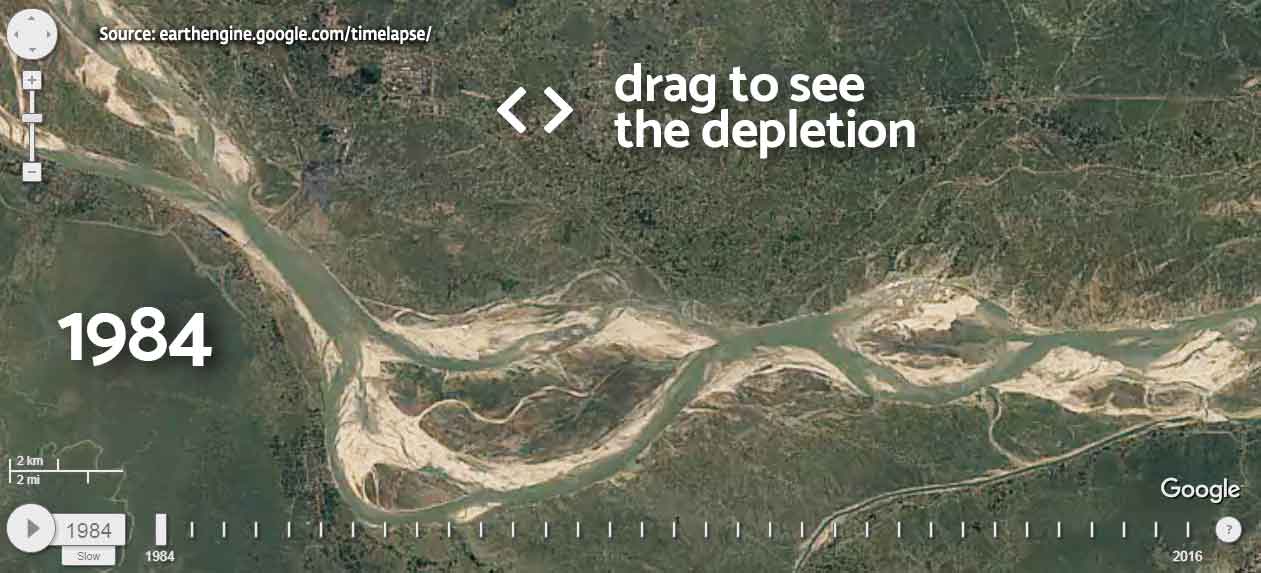River length: 2525 km
Basin area: 861,000 sq km
Population in basin: 329 million
States in basin: Uttarakhand, Uttar Pradesh, Bihar, Jharkhand, West Bengal


Major cities using water
New Delhi (pop: 11 million), Kolkata (pop: 4.5 million), Varanasi (pop: 1.2 million), Allahabad (pop: 1.1 million)
River Depletion
- Water depletion: 44%
- Dry season drought risk: Low
- Monsoon flood risk: Extremely high
- Total tree cover loss: 78%
- Seasonal variability of water levels: High
Economic & Environmental Significance
- The Gangetic region is one of the most fertile agricultural areas on the planet. It supports over 500 million people in five countries. Over 565,000 sq km are cultivated in this region in India, representing almost a third of the agricultural area in India.
- The Ganga was once an important navigational route. Even today, West Bengal uses the river to transport jute, tea, grain and other agricultural products.
- The Kolkata port, one of the major ports in India, is located on the Hooghly, a distributary of the Ganga.
- Two major species facing extinction are the gharial – a species of crocodile – and the Ganges Dolphin – one of only 7 freshwater dolphin species in the world. There are only about 200 gharials and 2000 Ganges Dolphin left.
Recent Disasters
The Ganga is one of the most endangered rivers in the world, according to WWF.
As with almost all Indian rivers, the Ganga is increasingly alternating between flood and drought. In May 2016, the Ganga was so dry at Prayag, Uttar Pradesh that people were walking across the river bed. Just three months later, the river’s monsoon floods touched record levels in Bihar and Uttar Pradesh, affecting 4 million and displacing 650,000 people from their homes. The flood coming immediately after drought had a catastrophic effect on agriculture.
Spiritual & Cultural Significance
The word “Ganga” literally means, “to flow”. The Ganga is almost synonymous with India, and is one of the fundamental threads of the nation’s spiritual and cultural ethos.
Many of India’s most sacred places – Rishikesh, Hardwar, Prayag and Kashi – are along its banks. In the Himalayas, Kedarnath, Badrinath and Gomukh are a few of the holy sites along the Ganga and its tributaries.
Two of the four places where the Kumbh Mela takes place are located on the Ganga – Hardwar and Prayag.
On the banks of the River Sone, one of Ganga’s tributaries, archaeologists found a 11,000-year old triangular stone, thought to be one of the oldest representations of a yantra, indicating worship of Shakti or the goddess.
The French philosopher Francis M. Voltaire was so awed by the Ganga that he said, “I am convinced that everything has come down to us from the banks of the Ganga – astronomy, astrology, spiritualism, etc. It is very important to note that some 2500 years ago at the least, Pythagoras went from Samos to the Ganga to learn geometry.” (translated from French)
Ganga jal or the Ganga’s water was regarded as amrit, the nectar of the gods, in the past. Akbar the Mughal emperor always carried a supply with him. The British East India Company used only Ganga water for its sailors during the three-month journey back to England, because it stayed “sweet and fresh” throughout. In 1896, a British bacteriologist noticed that Ganga water destroys cholera microbes.
References
- http://www.india-wris.nrsc.gov.in/wrpinfo/index.php?title=WRIS_Publications#Basin_Reports
- http://nelson.wisc.edu/sage/data-and-models/riverdata/index.php
- http://documents.worldbank.org/curated/en/983071491924854124/Major-Ganga-sub-basins-water-balance-analysis-report
- https://books.google.co.in/books?id=2W4WooQGUkMC&lpg=PT13&ots=vJMRepN6LG&pg=PT13#v=onepage&q&f=false
- http://www.npr.org/templates/story/story.php?storyId=17134270
- http://economictimes.indiatimes.com/news/politics-and-nation/river-ganga-can-fight-microorganisms-that-cause-tuberculosis-pneumonia-study/articleshow/54505873.cms